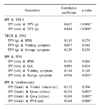Abstract
Purpose
Intravesical prostatic protrusion (IPP) is a morphological change that's due to excessive growth of the median and lateral lobes of the prostate into the bladder. Few studies have been performed regarding the correlation between IPP and the voiding/storage symptoms. The aim of this study is to identify the clinical significance of IPP by defining its relationship with the prostate volume (PV), the International Prostate Symptom Score (IPSS), the uroflowmetry results and the medication response.
Materials and Methods
We performed a retrospective study of 95 male patients who were examined between August 2006 and July 2007. The patients were evaluated with the IPSS/quality of life (QoL) test, uroflowmetry (Urodyn-1000™; Medtronic), the post void residual urine (PVR), and IPP and PV by transrectal ultrasound (TRUS) (PROSOUND SSD-3500™; ALOKA). The IPP was compared with the total IPSS, the voiding and storage symptom score, uroflowmetry parameters and the flow patterns (normal, obstructive, detrusor impairment, Valsalva). The patients were classified into two groups (the IPP and non-IPP groups) based on the presence of IPP as identified by TRUS.
Results
The PV and IPP showed a significant correlation (r=0.627, p< 0.001). There was no correlation between IPP and total IPSS (p=0.444); however, the storage symptom score was significantly increased in proportion to IPP (p=0.030). With an IPP increase, the Qmax was decreased (r=-0.319, p<0.001) and the PVR was increased (r=0.388, p=0.002). The IPP group showed a lower decrease of the QoL score after 8 weeks of medication, as compared to the non-IPP group (p=0.034).
Conclusions
The IPP showed significant correlation with the storage symptoms, but not with the total IPSS. Theoretically, IPP is a unique anatomical configuration of the prostate, and it may worsen the prominent storage symptoms that are the result of irritation of the bladder neck and trigone. IPP should be checked carefully during TRUS as IPP could potentially be a useful marker for the assessment and management of lower urinary tract symptoms.
Figures and Tables
 | Fig. 1Comparison of the International Prostate Symptom Score (IPSS) and the quality of life (QoL) according to the presence of intravesical prostatic protrusion at the initial visit (A), Comparison of the change of IPSS and the QoL according to the presence of intravesical prostatic protrusion after 8 weeks of medication (B), *p<0.05. |
Table 1
Correlation analysis between intravesical prostatic protrusion and the prostate volume/International Prostate Symptom Score/uroflowmetry parameters

Statistical significance was evaluated by correlation analysis, *p<0.05. IPP: intravesical prostatic protrusion, TRUS: transrectal ultrasound, TPV: total prostate volume, TZV: transitional zone volume, IPSS: International Prostate Symptom Score, QoL: quality of life, Qmax: maximal flow rate, Qavg: average flow rate, PVR: post voided residual urine
References
1. Nose H, Foo KT, Lim KB, Yokoyama T, Ozawa H, Kumon H. Accuracy of two noninvasive methods of diagnosing bladder outlet obstruction using ultrasonography: intravesical prostatic protrusion and velocity-flow video urodynamics. Urology. 2005. 65:493–497.
2. Kelly CE. Evaluation of voiding dysfunction and measurement of bladder volume. Rev Urol. 2004. 6:Suppl 1. 32–37.
3. Woodwell D. Office visit to urologists US, 1989-90, National Ambulatory Medical Care Survey. Advance Data from Vital and Health Statistics, no. 234. 1992. Bethesda, Maryland: National Center for Health Statistics;1–12.
4. Yang SK. How to determine the timing of surgery. J Korean Continence Soc. 2005. 9:Suppl. 41–50.
5. Yalla SV, Sullivan MP, Lecamwasam HS, DuBeau CE, Vickers MA, Cravalho EG. Correlation of American Urological Association symptom index with obstructive and nonobstructive prostatism. J Urol. 1995. 153:674–679.
6. Kaplan SA, Bowers DL, Te AE, Olsson CA. Differential diagnosis of prostatism: a 12-year retrospective analysis of symptoms, urodynamics and satisfaction with therapy. J Urol. 1996. 155:1305–1308.
7. Bruskewitz RC, Larsen EH, Madsen PO, Dørflinger T. 3-year followup of urinary symptoms after transurethral resection of the prostate. J Urol. 1986. 136:613–615.
8. Tempany CM, Partin AW, Zerhouni EA, Zinreich SJ, Walsh PC. The influence of finasteride on the peripheral and periurethral zones of the prostate in men with benign prostatic hyperplasia. Prostate. 1993. 22:39–42.
9. Abrams PH, Farrar DJ, Turner-Warwick RT, Whiteside CG, Feneley RC. The results of prostatectomy: a symptomatic and urodynamic analysis of 152 patients. J Urol. 1979. 121:640–642.
10. Lim KB, Ho H, Foo KT, Wong MY, Fook-Chong S. Comparison of intravesical prostatic protrusion, prostate volume and serum prostatic-specific antigen in the evaluation of bladder outlet obstruction. Int J Urol. 2006. 13:1509–1513.
11. Mariappan P, Brown DJ, McNeill AS. Intravesical prostatic protrusion is better than prostate volume in predicting the outcome of trial without catheter in white men presenting with acute urinary retention: a prospective clinical study. J Urol. 2007. 178:573–577.
12. Cho HJ, Kang JY, Yoo TK. The International Prostate Symptom Score: discrepancies between self-administration and physician-administration. Korean J Urol. 2007. 48:500–504.
13. McConnell JD. Why pressure-flow studies should be optional and mandatory studies for evaluating men with benign prostatic hyperplasia. Urology. 1994. 44:156–158.
14. Wadie BS, Ibrahim EH, de la Rosette JJ, Gomha MA, Ghoneim MA. The relationship of the IPSS and objective parameters for diagnosing bladder outlet obstruction. Part I: when statistics fail. J Urol. 2001. 165:32–34.
15. Kim BH, Sohn JC, Park CH, Kim CI. The usefulness of intravesical prostatic protrusion and bladder wall thickness measurement using transabdominal ultrasound in patients with benign prostatic hyperplasia. Korean J Urol. 2005. 46:1180–1185.
16. Yuen JS, Ngiap JT, Cheng CW, Foo KT. Effects of bladder volume on transabdominal ultrasound measurements of intravesical prostatic protrusion and volume. Int J Urol. 2002. 9:225–229.
17. Chia SJ, Heng CT, Chan SP, Foo KT. Correlation of intravesical prostatic protrusion with bladder outlet obstruction. BJU Int. 2003. 91:371–374.
18. Park SY, Cho JS, Hong CH, Lee KS. The clinical value of residual urine checked by transrectal ultrasonography. Korean J Urol. 2007. 48:951–955.




 PDF
PDF ePub
ePub Citation
Citation Print
Print



 XML Download
XML Download